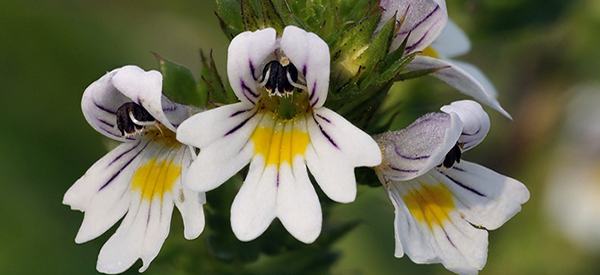Its botanical name is Euphrasia officinalis, but most people know it simply as eyebright. The name says it all – eyebright is best known as a remedy for eye problems. People have been relying on it to improve their eyesight for centuries. In fact, the herb was first mentioned way back in 1305 in Gordon’s Liticium Medicina where it is “recommended both outwardly in a compound distilled water, and inwardly as a syrup”.
Eyebright or Euphrasia belongs to the Figwort family. It is indigenous to Europe, Northern and Western Asia, and North America. About 450 different species have been recorded although they all have the same medicinal properties.
The small, elegant plant with its wiry stem generally has numerous tiny white or lavender flowers, variegated with yellow. They resemble a bloodshot eye, with a yellow dot to assist bees with pollination. Preppers use the entire flowering plant, including the roots, in homeopathic remedies and herbal medicine.
Related: 10 Trees Every Survivalist Should Know and Why
Chemical, Organic and Nutritional Properties of Eyebright
Eyebright contains vitamins B, C, E, and beta-carotene. In addition, it is full of antioxidants such as caffeic acids, ferulic acids and flavonoids, iridoid glycosides, defensive compounds, tannins and volatile oils. Its many chemical, organic and nutritional properties not only aids in treating eye problems but may also help with a number of other health conditions.
The Medicinal Qualities of Eyebright
Eyebright strengthens the head, eyes, and memory and clears the sight. – Salmon (Syn.Med., 1671)
1. Eyebright to Improve Eyesight
Eyebright is mainly used to treat a broad spectrum of eye problems. These include dry and tired eyes, infections, allergies, short-sightedness, irritations, and glaucoma. It is furthermore beneficial in the treatment of inflammation of the iris, cornea, tear ducts, eyelid and the membrane lining the eyelids.
Research has shown that especially the astringent compounds called tannins in eyebright reduce inflammation and swelling in the eye. They are also responsible for creating a protective coating on the surface of the eye. Herbal remedies containing eyebright works quickly to brighten the eyes and clear blockages. It provides almost immediate relief from burning, inflamed, red and aggravated eyes.
2. Eyebright to Improve the Functioning of the Respiratory Tract
The astringent properties in eyebright make it ideal to use as an anti-inflammatory for upper respiratory tract infections, sinusitis, hay fever, and inflammation of the mucous membranes. It is ideal for relieving excess mucous. Herbalists from the 19th century traditionally gave eyebright to patients affected by coughs and hoarseness of voice. Today, the dried herb is an ingredient in British Herbal Tobacco which is smoked for chronic bronchial colds.
3. Eyebright to Treat Skin Conditions and Other Uses
When made into a poultice and applied topically, eyebright aids in the healing of skin wounds. It is furthermore used to treat acne and relieves inflammation of the skin.
Lesser known uses of eyebright include the stimulation of a healthy liver through the cleansing and purification of the blood. It is also said to alleviate headaches and earache.
Related: 23 Survival Uses for Honey that You Didn’t Know About
Possible Side Effects of Eyebright
As with all herbal remedies and medication, there is a chance of an allergic reaction. Therefore, it is always advisable to discuss it with your physician before use.
When used to treat eye problems, side effects could include itching, redness, intolerance of bright light, swelling or changes in vision. Other side effects that have been recorded are sneezing, insomnia, confusion, tearing, sweating, nausea, toothache, coughing, headache, nasal congestion, constipation, hoarseness and excessive urination.
Preparing Your Own Eyebright Solution
Eyebright remedies usually come in two forms – liquid or dried – which can be used topically or orally.
For an eye wash, combine half a teaspoon of fresh or dried eyebright with one cup of gin or brandy. Pour the mixture into an airtight container, and shake the container every couple of days for a month. Strain the mixture and add 30 drops of this tincture to 1 cup of boiling water to use as an eye wash or eye drops.
To use eyebright orally, a tea made with dried eyebright works wonders. All you need to do is to add one-half to a full teaspoon of dried eyebright to 5 ounces of boiling water and leave it for 10 minutes. Strain the tea before drinking.
Related: How To Make a Powerful Calendula Extract to Keep in Your Medicine Cabinet (with pictures)
How to Grow Eyebright in Your Back Yard
Eyebright grows in the United States Department of Agriculture Hardiness Zones 1 to 9. The herbaceous plant thrives in open fields such as grasslands, meadows and next to roads. It prefers rich soil where it grows into small bushes of up to 9 or 10 inches in height. In poor soil or rocky areas, the stem won’t branch fully and the plant will only grow about 4 inches high. But you can also grow it indoors if you have a greenhouse. If you don’t have one, here’s how to make your own Mini-Greenhouse for year-round vegetables.
All you need to successfully grow your own eyebright are seeds, a seed-growing medium (if required), a rake, and a sunny, grassy area.
Step-by-Step Growing Guide
- Sow your seeds in the fall months between September and December. The reason is that they need a prolonged period of chilling (about 90 days) to trigger their germination the following spring. The best place to sow eyebright is a sunny field where the grass is not too thick. Alternatively, you can create an artificial environment for chilling by sowing the seeds in a moist growing medium and keeping it in a refrigerator for 90 days.
- Prepare by cutting the grass in the sowing area very short (1 inch will do) and opening sites for germination by harrowing or raking. Loosening the soil to a depth of about 1 inch is adequate. Eyebright is semi-parasitic, drawing nutrients from surrounding plants. Therefore, it should be planted close to grass while at the same time leaving enough space for it to grow.
- Distribute the seeds over the prepared soil. They are very fine, so there is no need for a heavy application. Make sure they are firmly embedded before covering them with the loosened soil.
- Keep the germinating seeds moist without over watering them. Test the moisture levels by forming a ball with a little bit of soil. Although the soil should stick together, no water should run out if you squeeze the ball.
- When the little eyebright plants start to show themselves, they must be allowed to grow undisturbed until August. That means no mowing or grazing. By August the wildflowers will be in full bloom. Once they have set seed, mowing and grazing can resume to maintain sward structure.
Good luck with growing your own eyebright and ensuring good eyesight well into your old age!
You may also like:
 Potassium Permanganate: Why You Need It in Your Survival Kit?
Potassium Permanganate: Why You Need It in Your Survival Kit?
The Lost Ways 2 by Claude Davis (Video)
10 Health Benefits of Cinnamon That Surprised Even Us












buy seeds where?
You can find them on Amazon: https://www.amazon.com/SAFLAX-Eyebright-seeds-Euphrasia-officinalis/dp/B01N0NI8Q7
where to buy seeds?
I cnnot use a digital copy book I need a hard copy can I buy one if aao frim where?
We would buy if there was an actual book and not a digital copy only.
What part of the plant do you harvest? I would guess the leaves, but don’t want to assume.
Same comment as others Where do you buy seeds for this plant? Care to divulge this information?
why would you
claude we need some info. here.